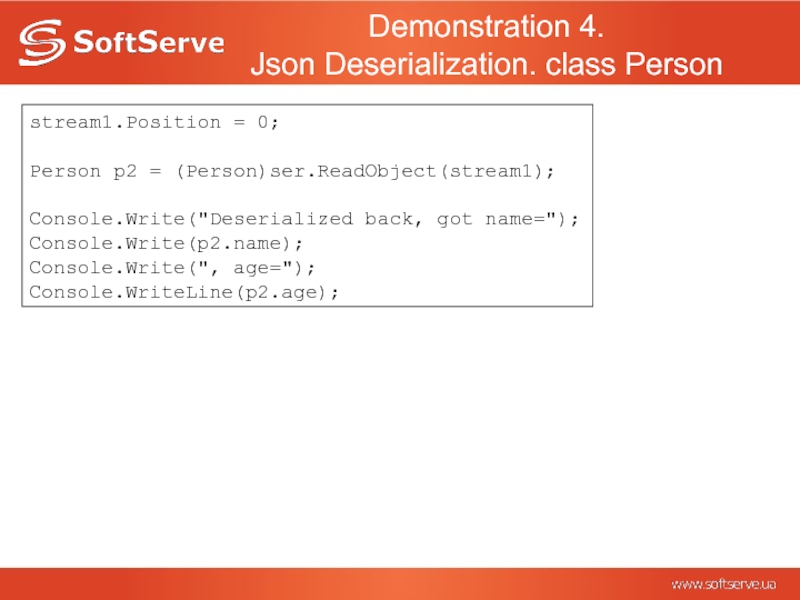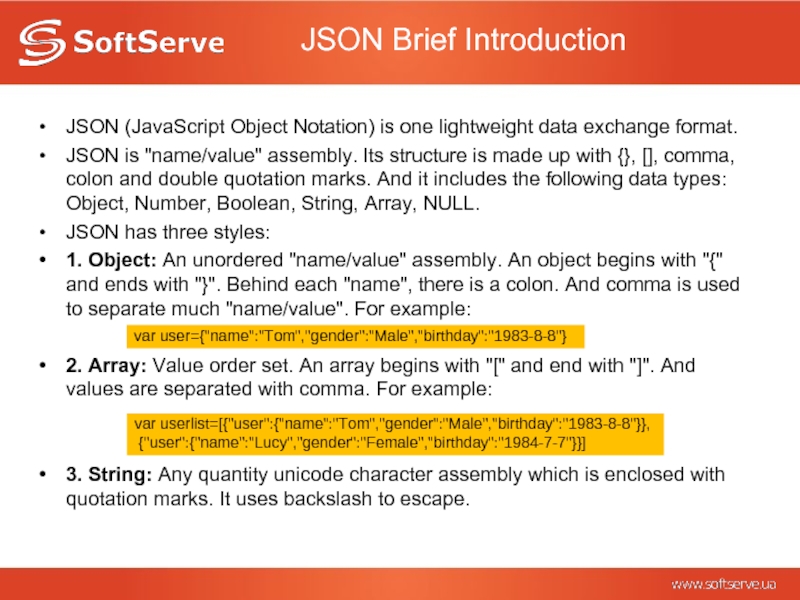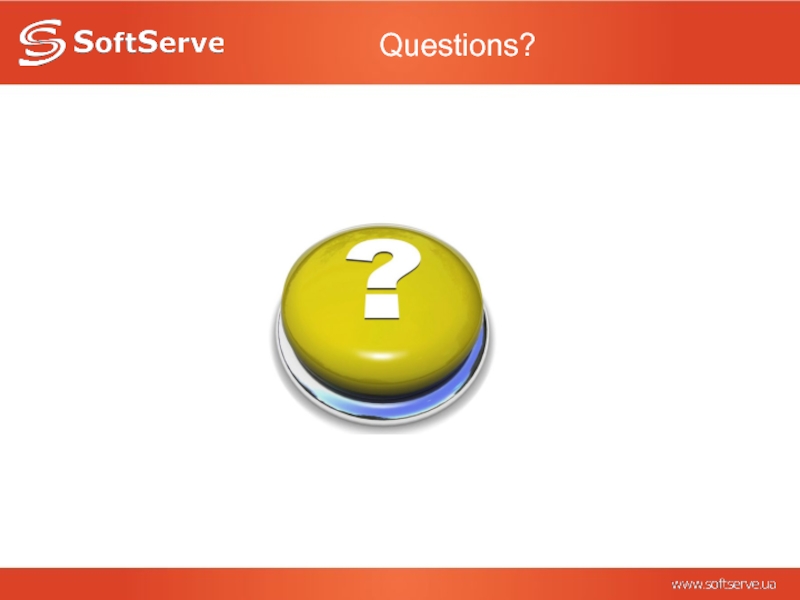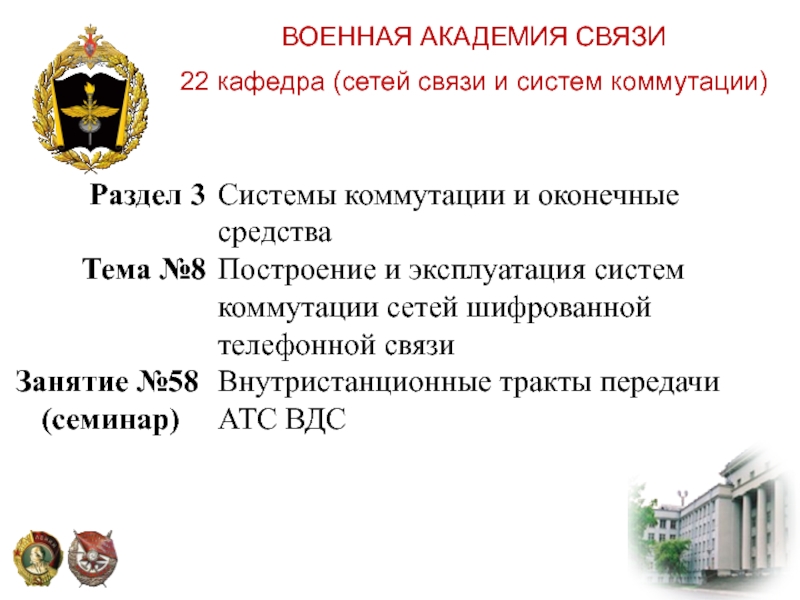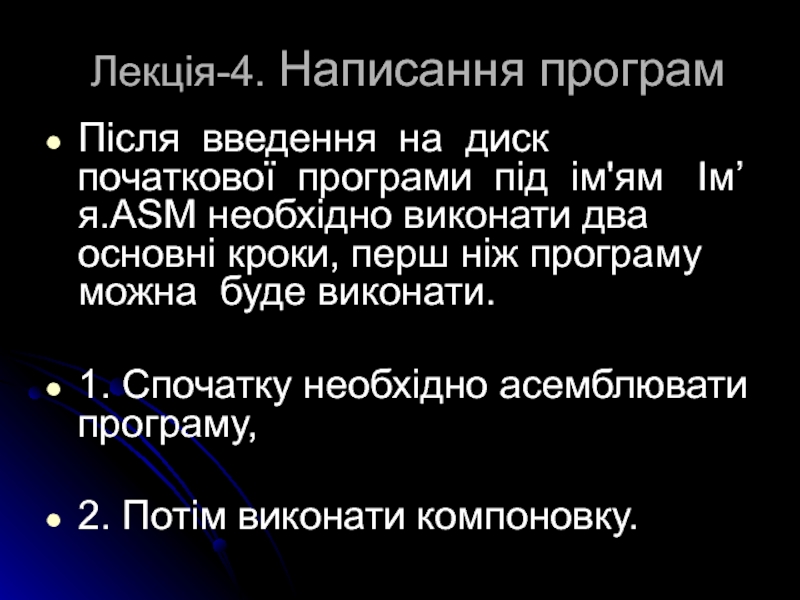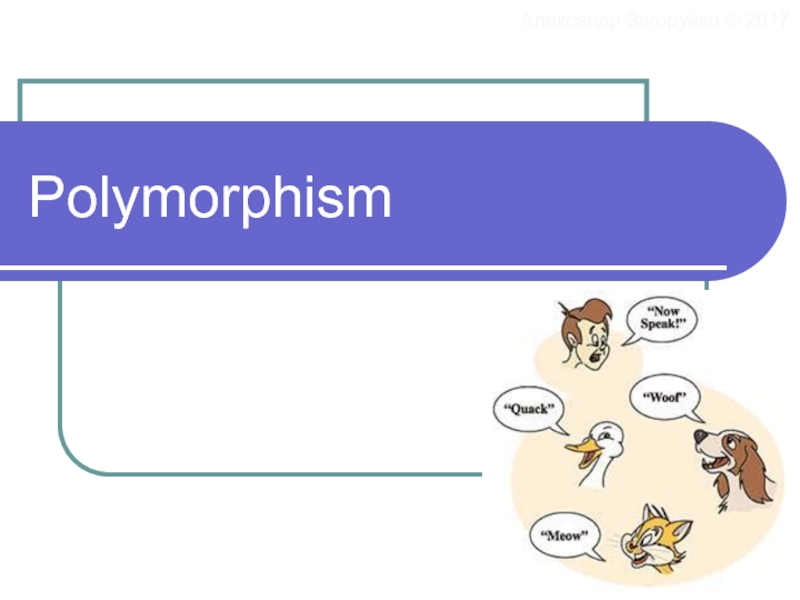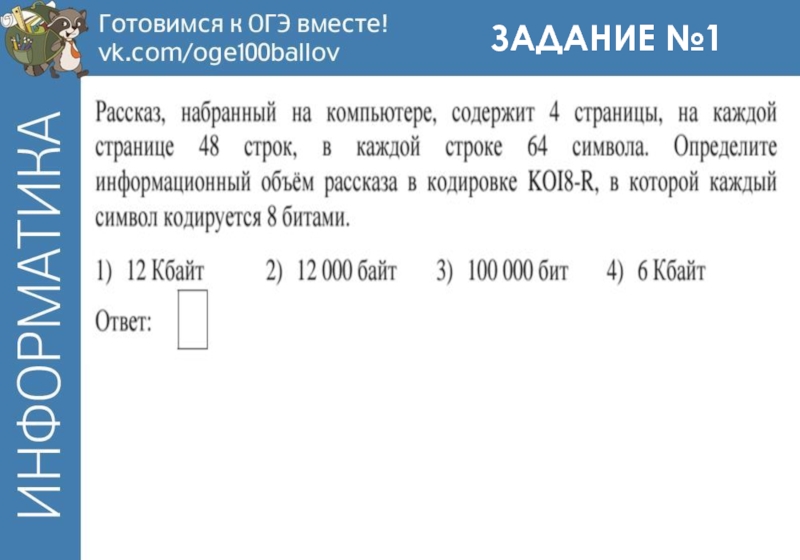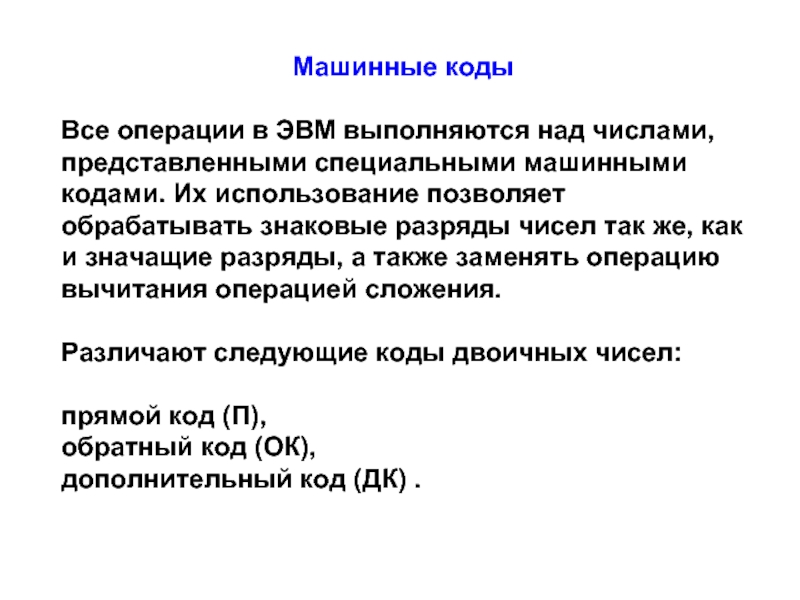- Главная
- Разное
- Дизайн
- Бизнес и предпринимательство
- Аналитика
- Образование
- Развлечения
- Красота и здоровье
- Финансы
- Государство
- Путешествия
- Спорт
- Недвижимость
- Армия
- Графика
- Культурология
- Еда и кулинария
- Лингвистика
- Английский язык
- Астрономия
- Алгебра
- Биология
- География
- Детские презентации
- Информатика
- История
- Литература
- Маркетинг
- Математика
- Медицина
- Менеджмент
- Музыка
- МХК
- Немецкий язык
- ОБЖ
- Обществознание
- Окружающий мир
- Педагогика
- Русский язык
- Технология
- Физика
- Философия
- Химия
- Шаблоны, картинки для презентаций
- Экология
- Экономика
- Юриспруденция
Introduction to serialization презентация
Содержание
- 1. Introduction to serialization
- 2. Agenda What is Serialization?
- 3. What is Serialization? Serialization is the process
- 4. Serialization in .NET
- 5. Serialization in .NET .NET Framework has classes
- 6. Binary serialization In binary serialization all items
- 7. BinaryFormatter [Serializable] class Person {
- 8. To indicate that instances of this type
- 9. Custom serialization. ISerializable With a custom serialization,
- 10. ISerializable. Example of implementation [Serializable]
- 11. Custom serialization. Using attributes Add attribute
- 12. XMLSerializer The XmlSerializer (namespace System.Xml.Serialization) was
- 13. XMLSerializer To deserialize an object: Construct a
- 14. XMLSerializer You can configure how the XmlSerializer
- 15. Complex and derived types serialization [Serializable] public
- 16. Complex and derived types serialization private static
- 17. Using DataContract DataContract is used when you
- 18. Using DataContract [DataContract] public class PersonDataContract {
- 19. Using DataContract PersonDataContract p = new PersonDataContract{
- 20. NetDataContractSerializer Diffrence between DataContractSerializer and NetDataContractSerializer is
- 21. JSON Serialization We can use DataContractJsonSerializer
- 22. Demonstration 4. Json Serialization. class Person
- 23. Demonstration 4. Json Deserialization. class Person
- 24. JSON Brief Introduction JSON (JavaScript Object Notation)
- 25. Questions?
Слайд 1Introduction to Serialization
Last update:
Lesya Klakovych
August 2016
Reviewed by Nazar Ivchenko
Слайд 2Agenda
What is Serialization?
Serialization in .NET
Binary serialization
Custom serialization
Using DataContract
Serialization in JSON format
Слайд 3What is Serialization?
Serialization is the process of transforming an object or
Deserialization is the opposite. You take some bytes or text and transform them into an object.
[Serializable]
public class Person
{
…
}
Person st1 = new Person();
st1.FirstName = “Iryna";
st1.LastName = “Koval";
st1.BirthDate = new DateTime(1981, 8, 17);
Слайд 5Serialization in .NET
.NET Framework has classes (in the System.Runtime.Serialization and System.Xml.Serialization
binary,
XML,
JSON,
own custom serialization.
The .NET Framework offers three serialization mechanisms that you can use by default:
BinaryFormatter
XmlSerializer
DataContractSerializer
Слайд 6Binary serialization
In binary serialization all items are serialized, even private field
In binary serialization, there is used a binary encoding to provide a compact object serialization for storage or transmission in a network flows based on sockets.
It is not suitable for data transmission through the firewall, but provides better performance while saving data.
namespace System.Runtime.Serialization.Formatters.Binary
classes BinaryFormatter and SoapFormatter .
Слайд 7BinaryFormatter
[Serializable]
class Person {
private int _id;
public string FirstName;
public void SetId(int id)
{
_id = id;
}
}
Person person = new Person();
person.SetId(1);
person.FirstName = "Joe";
person.LastName = "Smith";
IFormatter formatter = new BinaryFormatter();
Stream stream = new FileStream("Person.bin",
FileMode.Create, FileAccess.Write, FileShare.None);
formatter.Serialize(stream, person);
stream.Close();
stream = new FileStream("Person.bin",
FileMode.Open,FileAccess.Read,FileShare.Read);
Person person2 =(Person)formatter.Deserialize(stream);
stream.Close();
Слайд 8To indicate that instances of this type can be serialized, mark
If you do not want to serialize the fields within a class, apply the [NonSerialized] attribute.
If a serializable class contains references to objects of other classes that are marked with a [Serializable] attribute, those objects are also serializable.
the [OptionalField] attribute is used to make sure that the binary serializer knows that a field is added in a later version and that earlier serialized objects won’t contain this field
BinaryFormatter
Слайд 9Custom serialization. ISerializable
With a custom serialization, you can specify exactly which
This class must be marked with the SerializableAttribute attribute and implement the Iserializable interface .
ISerializable interface: the Formatter calls the GetObjectData() at serialization time and populates the supplied SerializationInfo with all the data required to represent the object . For the custom deserialization, you should use a custom constructor.
Слайд 10ISerializable.
Example of implementation
[Serializable]
public class Person : ISerializable
{
public string FirstName;
public string LastName;
public void SetId(int id)
{
_id = id;
}
public Person() { }
public Person(SerializationInfo info, StreamingContext context)
{
FirstName = info.GetString("custom field 1");
LastName = info.GetString("custom field 2");
}
public void GetObjectData(SerializationInfo info, StreamingContext context)
{
info.AddValue("custom field 1", FirstName);
info.AddValue("custom field 2", LastName);
}
}
Слайд 11Custom serialization. Using attributes
Add attribute before a custom method that
OnDeserializedAttribute, OnDeserializingAttribute, OnSerializedAttribute, and OnSerializingAttribute.
[OnSerializing()]
internal void OnSerializingMethod(StreamingContext context)
{ FirstName = "Bob";}
[OnSerialized()]
internal void OnSerializedMethod(StreamingContext context)
{ FirstName = "Serialize Complete"; }
[OnDeserializing()]
internal void OnDeserializingMethod(StreamingContext context)
{ FirstName = "John"; }
[OnDeserialized()]
internal void OnDeserializedMethod(StreamingContext context)
{ FirstName = "Deserialize Complete"; }
Слайд 12XMLSerializer
The XmlSerializer (namespace System.Xml.Serialization) was created with the idea of
To serialize an object:
Create the object and set its public fields and properties.
Construct a XmlSerializer using the type of the object.
Call the Serialize method to generate either an XML stream or a file representation of the object's public properties and fields.
Person2 st1 = new Person2();
// Insert code to set properties and fields of the object.
XmlSerializer xmlser = new XmlSerializer(typeof(Person2));
Stream serialStream = new FileStream("person.xml", FileMode.Create);
xmlser.Serialize(serialStream, st1);
Слайд 13XMLSerializer
To deserialize an object:
Construct a XmlSerializer using the type of the
Call the Deserialize method to produce a replica of the object. After deserialization you must cast the returned object to the type of the original
serialStream = new FileStream("person.xml", FileMode.Open);
Person2 st2 = xmlser.Deserialize(serialStream) as Person2;
Console.WriteLine(st2);
// Displays
//
//
//
//
//
Слайд 14XMLSerializer
You can configure how the XmlSerializer serializes your type by using
XmlIgnore - can be used to make sure that an element is not serialized
XmlAttribute - you can map a member to an attribute on its parent node.
XmlElement – by default
XmlArray - is used when serializing collections.
XmlArrayItem - is used when serializing collections.
Слайд 15Complex and derived types serialization
[Serializable]
public class Person
{
public string
public string LastName { get; set; }
public int Age { get; set; }
}
[Serializable]
public class VIPOrder : Order
{
public string Description { get; set;}
}
[Serializable]
public class OrderLine
{
[XmlAttribute]
public int ID { get; set; }
[XmlAttribute]
public int Amount { get; set; }
[XmlElement(“OrderedProduct”)]
public Product Product { get; set; }
}
[Serializable] [Serializable]
public class Order
{
[XmlAttribute]
public int ID { get; set; }
[XmlIgnore]
public bool IsDirty { get; set; }
[XmlArray(“Lines”)]
[XmlArrayItem(“OrderLine”)]
public List
}
public class Product
{
[XmlAttribute]
public int ID { get; set; }
public decimal Price { get; set; }
public string Description { get; set; }}
Слайд 16Complex and derived types serialization
private static Order CreateOrder()
{
Product
Product p2 = new Product { ID = 2, Description = “p3”, Price = 6 };
Order order = new VIPOrder { ID = 4, Description = “Order for John Doe. Use the nice giftwrap”,
OrderLines = new List
new OrderLine { ID = 5, Amount = 1, Product = p1},
new OrderLine { ID = 6 ,Amount = 10, Product = p2},
}
};
return order;
}
XmlSerializer serializer = new XmlSerializer(typeof(Order), new Type[] { typeof(VIPOrder) });
string xml;
using (StringWriter stringWriter = new StringWriter())
{
Order order = CreateOrder();
serializer.Serialize(stringWriter, order);
xml = stringWriter.ToString();
}
using (StringReader stringReader = new StringReader(xml))
{ Order o = (Order)serializer.Deserialize(stringReader);
// Use the order}
Слайд 17Using DataContract
DataContract is used when you use WCF.
The DataContractSerializer is
You should use DataContractAttribute instead of SerializableAttribute.
The class members are not serialized by default. You have to explicitly mark them with the DataMember attribute.
As with binary serialization, you can use OnDeserializedAttribute, OnDeserializingAttribute, OnSerializedAttribute, and OnSerializingAttribute to configure the four phases of the serialization and deserialization process.
Слайд 18Using DataContract
[DataContract]
public class PersonDataContract
{
[DataMember]
public
[DataMember]
public string Name { get; set; }
private bool isDirty = false;}
You can use the DataContractSerializer from the System.Runtime.Serialization namespace in the same way you used the XmlSerializer and BinarySerializer.
You need to specify a Stream object that has the input or output when serializing or deserializing an object.
Слайд 19Using DataContract
PersonDataContract p = new PersonDataContract{ Id = 1, Name =
using (Stream stream = new FileStream(“data.xml”, FileMode.Create))
{
DataContractSerializer ser = new DataContractSerializer(typeof(PersonDataContract));
ser.WriteObject(stream, p);
}
using (Stream stream = new FileStream(“data.xml”, FileMode.Open))
{
DataContractSerializer ser = new DataContractSerializer(typeof(PersonDataContract));
PersonDataContract result = (PersonDataContract)ser.ReadObject(stream);
}
Слайд 20NetDataContractSerializer
Diffrence between DataContractSerializer and NetDataContractSerializer is that the NetDataContractSerializer passes type
Here is the DataContractSerializer version of the Person data
And here is the version from the NetDataContractSerializer
As you can see the NetDataContractSerializer included information about the type and the assembly which can be used on the client side.
Слайд 21JSON Serialization
We can use DataContractJsonSerializer to serialize type instance to JSON
DataContractJsonSerializer is under System.Runtime.Serialization.Json namespace.
It is included in System.ServiceModel.Web.dll in .NET Framework 3.5 and System.Runtime.Serialization in .NET Framework 4.0. We need to add it as reference
http://www.codeproject.com/Articles/272335/JSON-Serialization-and-Deserialization-in-ASP-NET#
Слайд 22Demonstration 4.
Json Serialization. class Person
[DataContract]
internal class Person
[DataMember]
internal string name;
[DataMember]
internal int age;
}
Person p = new Person();
p.name = "John";
p.age = 42;
MemoryStream stream1 = new MemoryStream();
DataContractJsonSerializer ser = new DataContractJsonSerializer(typeof(Person));
ser.WriteObject(stream1, p);
stream1.Position = 0;
StreamReader sr = new StreamReader(stream1);
Console.Write("JSON form of Person object: ");
Console.WriteLine(sr.ReadToEnd());
Слайд 23Demonstration 4.
Json Deserialization. class Person
stream1.Position = 0;
Person p2 = (Person)ser.ReadObject(stream1);
Console.Write("Deserialized
Console.Write(p2.name);
Console.Write(", age=");
Console.WriteLine(p2.age);
Слайд 24JSON Brief Introduction
JSON (JavaScript Object Notation) is one lightweight data exchange
JSON is "name/value" assembly. Its structure is made up with {}, [], comma, colon and double quotation marks. And it includes the following data types: Object, Number, Boolean, String, Array, NULL.
JSON has three styles:
1. Object: An unordered "name/value" assembly. An object begins with "{" and ends with "}". Behind each "name", there is a colon. And comma is used to separate much "name/value". For example:
2. Array: Value order set. An array begins with "[" and end with "]". And values are separated with comma. For example:
3. String: Any quantity unicode character assembly which is enclosed with quotation marks. It uses backslash to escape.
var user={"name":"Tom","gender":"Male","birthday":"1983-8-8"}
var userlist=[{"user":{"name":"Tom","gender":"Male","birthday":"1983-8-8"}},
{"user":{"name":"Lucy","gender":"Female","birthday":"1984-7-7"}}]
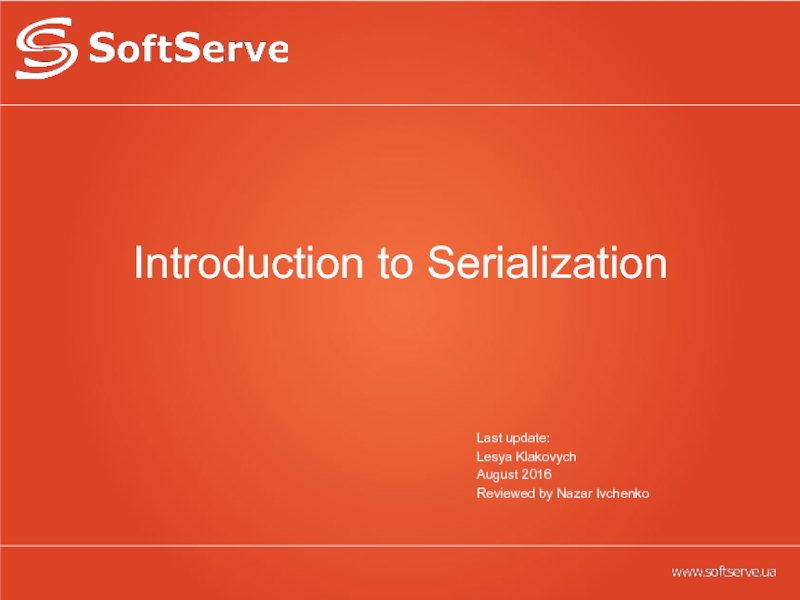
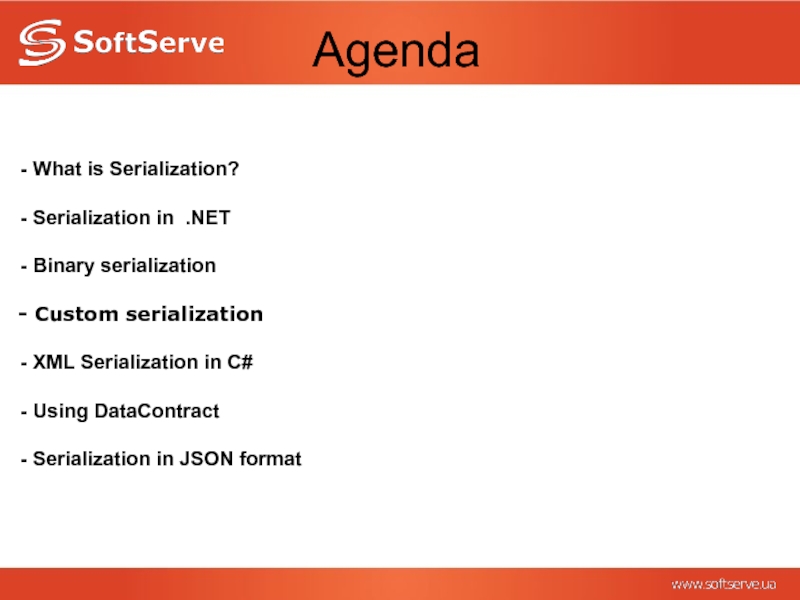
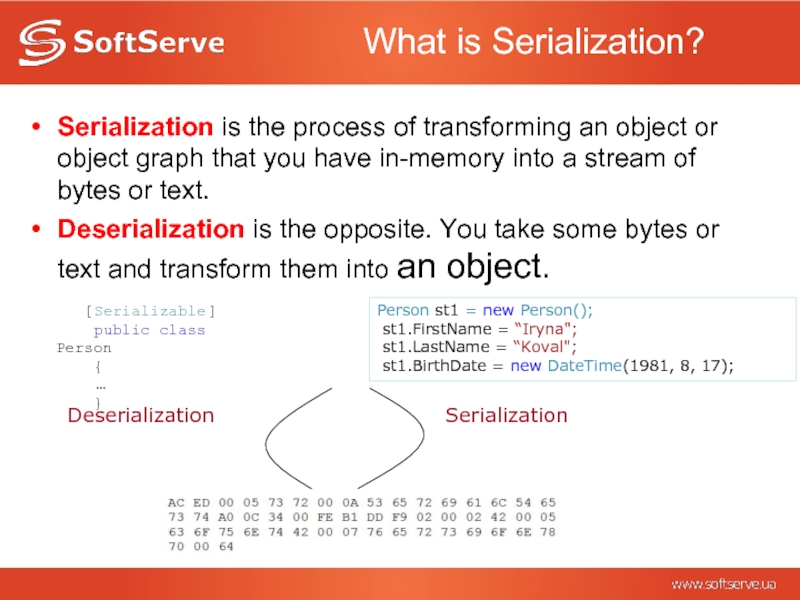
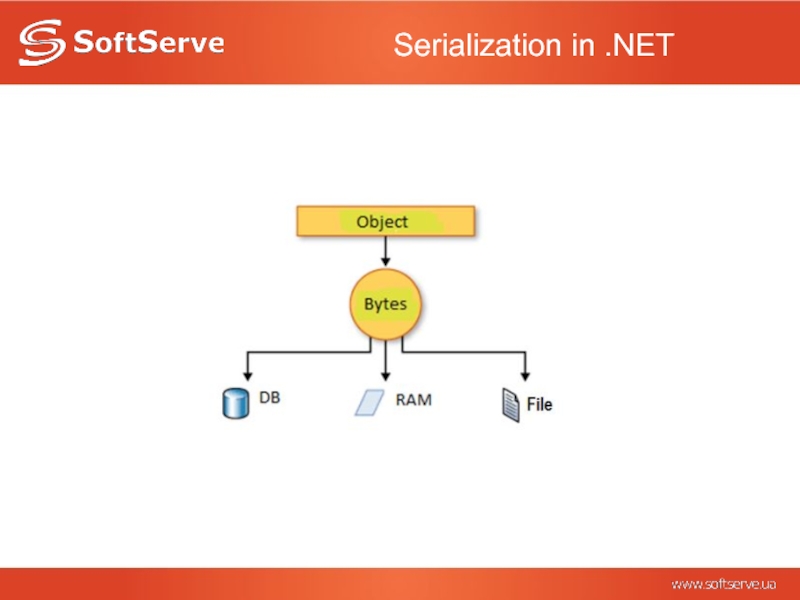

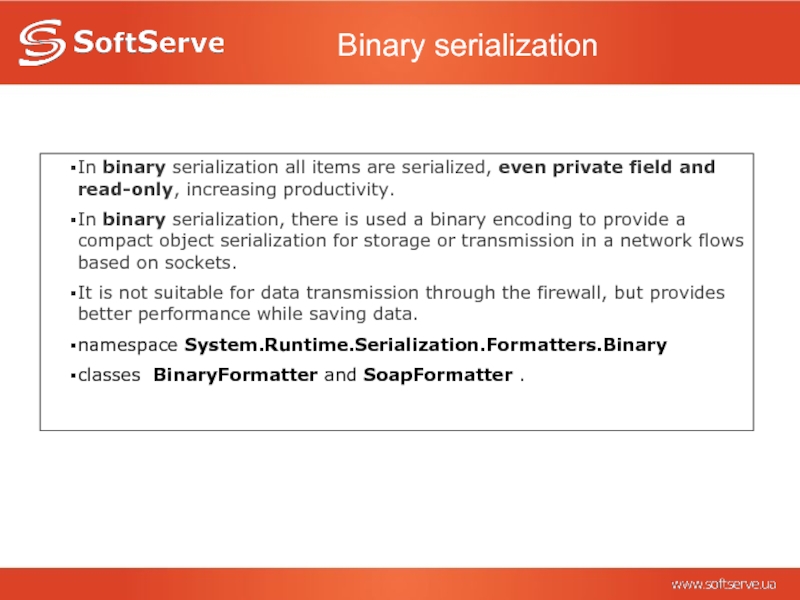
![BinaryFormatter[Serializable]class Person { private int _id; public string FirstName; public string LastName; public void SetId(int](/img/tmb/1/48442/6ce82dadfd0a3649ace73beb98b5e1fb-800x.jpg)
![To indicate that instances of this type can be serialized, mark it with the [Serializable]](/img/tmb/1/48442/f6128a0b4e030c3c1eab5050a0c1fc6c-800x.jpg)
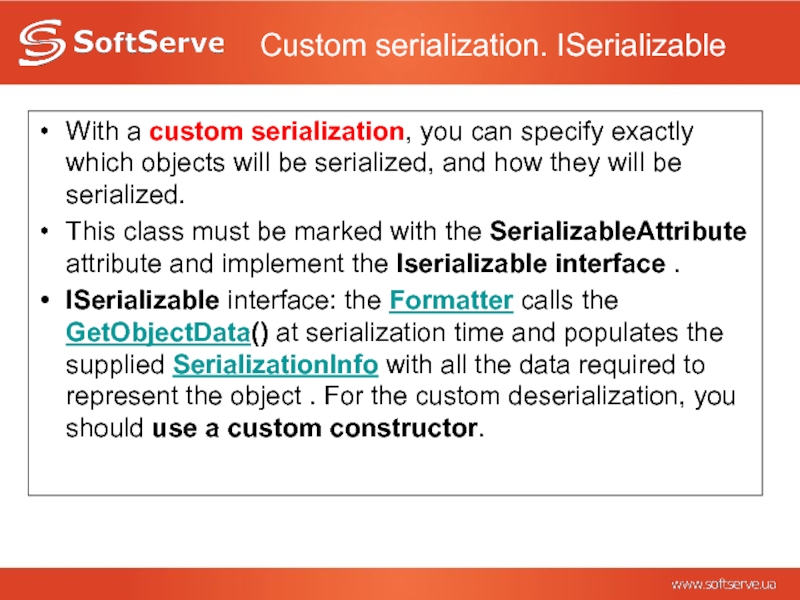
![ISerializable. Example of implementation[Serializable] public class Person : ISerializable { private int _id;](/img/tmb/1/48442/a81b48df41cb5501452fbdc98c82d221-800x.jpg)
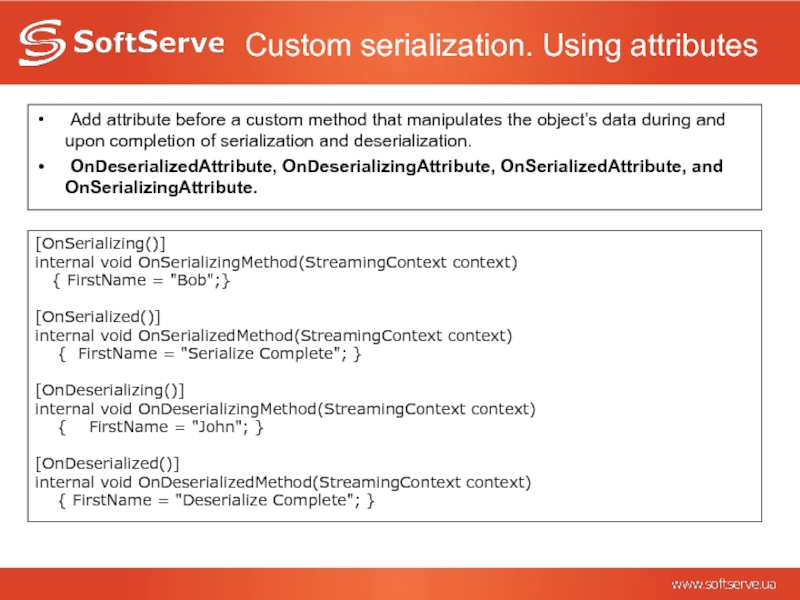
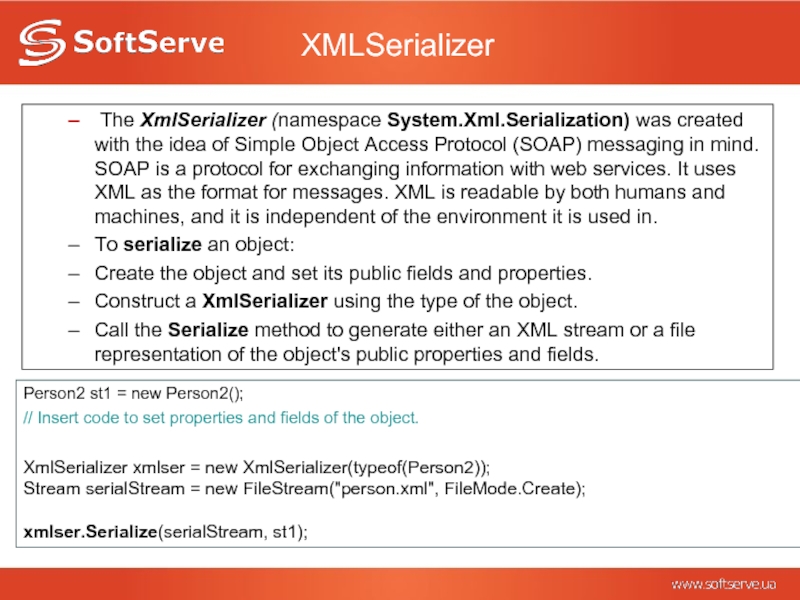
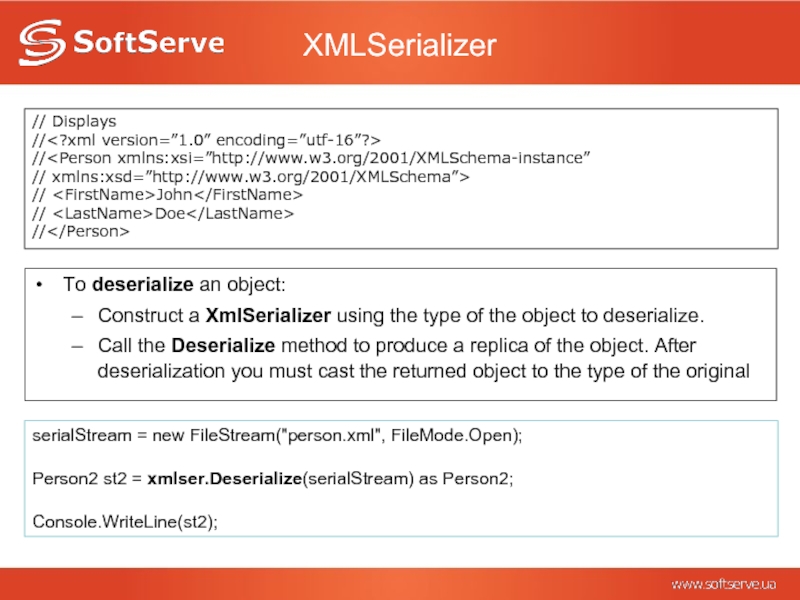
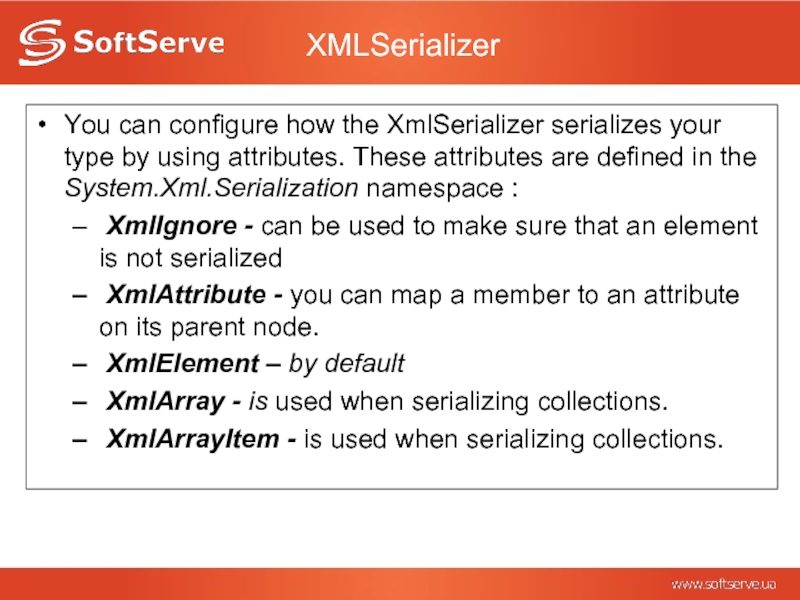
![Complex and derived types serialization[Serializable]public class Person{ public string FirstName { get; set; }](/img/tmb/1/48442/9373c83ab46f5f25de66ab30a9b18a5f-800x.jpg)
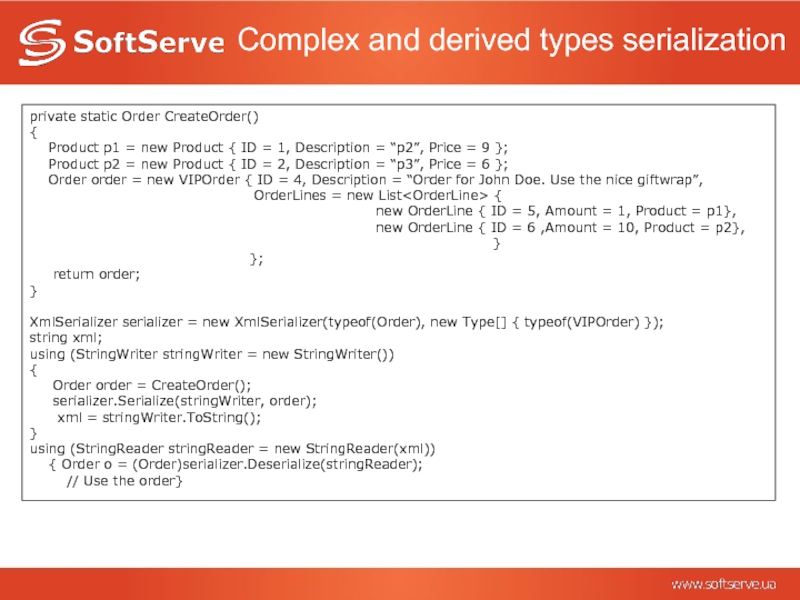
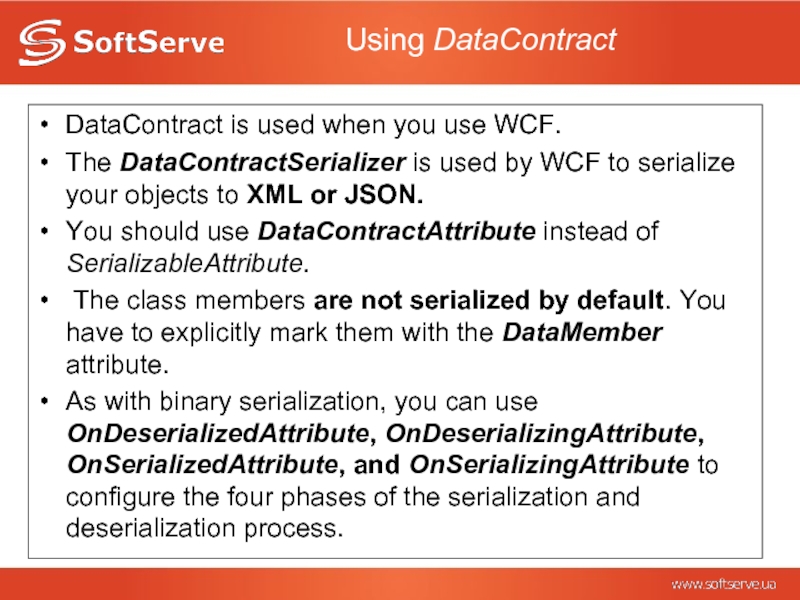
![Using DataContract[DataContract]public class PersonDataContract{ [DataMember] public int Id { get; set; }](/img/tmb/1/48442/50000e8573601a1dc8853ca6abf27929-800x.jpg)
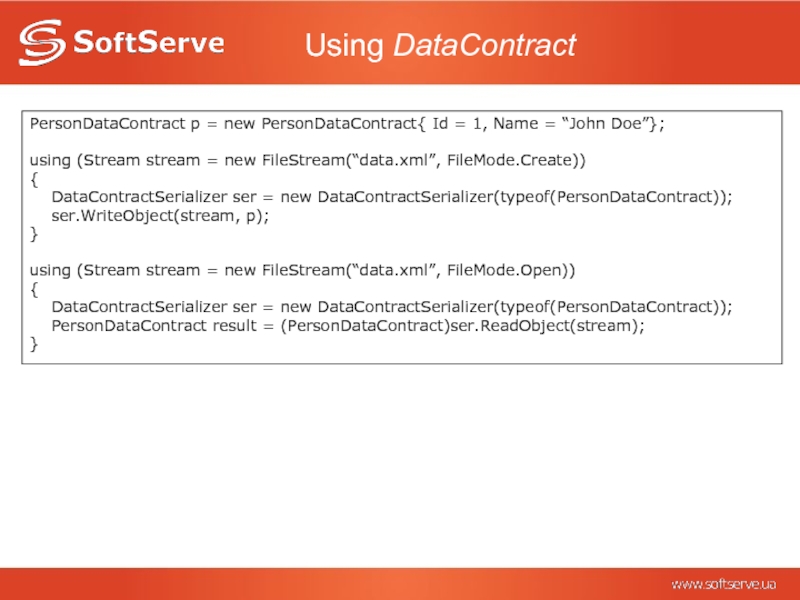
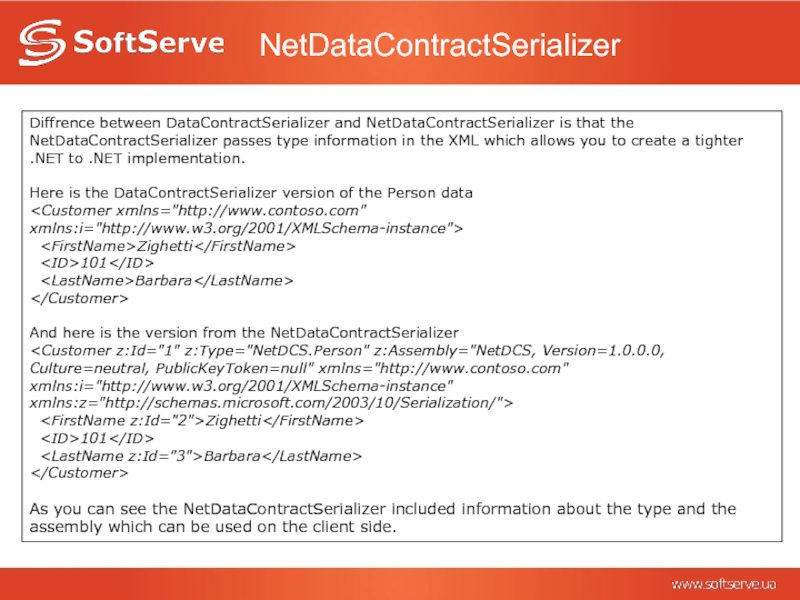
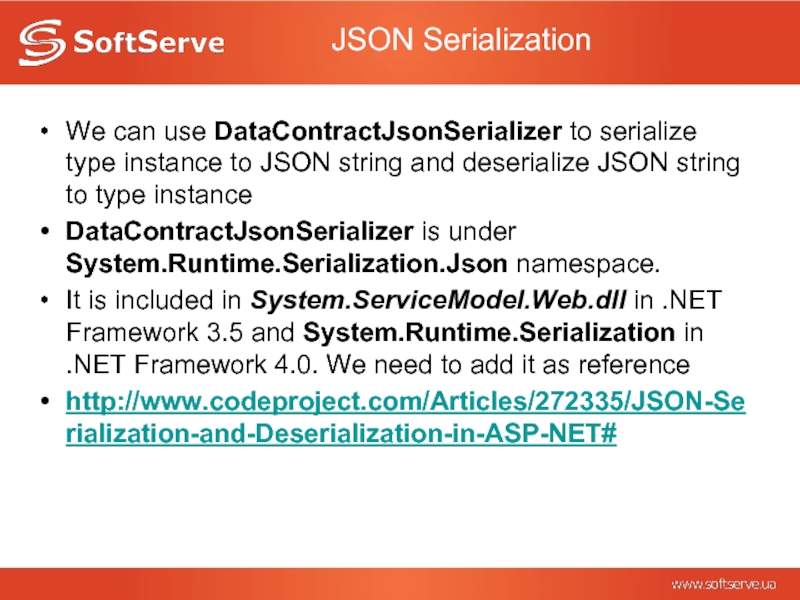
![Demonstration 4. Json Serialization. class Person[DataContract] internal class Person { [DataMember] internal string](/img/tmb/1/48442/d4a7f80bc9a760ed567e52429e56d062-800x.jpg)
